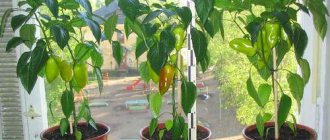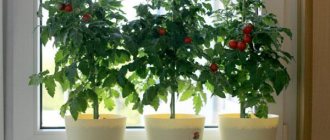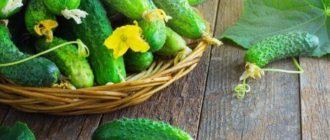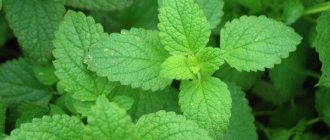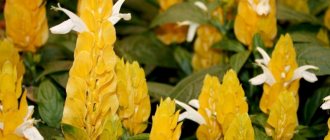Daria Vorontsova
Reading time: 10 minutes
AA
Exotic plants have long been grown at home. After all, they not only create comfort in the apartment, but also have useful properties. Cardamom is called the king of spices; this spice is one of the most expensive in the world. The plant belongs to the ginger family. Its leaves and fruits have a pronounced camphor aroma with notes of mint and citrus.
An evergreen bush can be grown at home on a windowsill, but you will have to put in a lot of effort. But the fragrant bush will please the eye, and you can count on a harvest.
The spicy-sweet spice is added to hot and sweet dishes, or to tea or coffee.
Cardamom varieties for growing on a windowsill
It is possible to grow a bush at home, but the appearance will be slightly different from its counterpart that grew in natural conditions. The most popular varieties of cardamom:
| Variety | Peculiarity |
| Green | The fruits ripen in green boxes, inside of which the grains are brown. One of the most common varieties. In cooking it is added to dough. |
| Black | The plant produces fruits in the form of black grains. Their aroma is similar to the smell of smoke, and they taste sharp. The plant is highly valued both as a spice and for its medicinal properties. |
| Ethiopian | This variety is an analogue of black cardamom. The fruits have a pronounced spicy aroma, but the spice is of lower quality. |
| White | Suitable for food use. The spice has a mild taste and lacks characteristic pungency. |
The most commonly used are black and green cardamom. The black variety has more than 179 subspecies, and the green variety has 11 varieties. Despite the fact that evergreen bushes do not grow in Russia, you can buy seed material at a flower shop.
Description of cardamom
There are features that characterize this particular plant. Firstly, Eletaria cardamomum has a powerful root system. Secondly, grass has two stems. On the false one you can see a lot of foliage. They are all a dark green shade. If you rub them in your hand, you can feel a fairly strong aroma.
While some people adore this smell, others claim that it is quite unpleasant. There are leaves on the real stem. But there are tassels of flowers on it. Each one opens from two to three buds. After the flowering period ends, black seeds appear.
What you need to grow cardamom
Growing exotic plants at home is painstaking work. After all, in natural conditions they are accustomed to a warm climate and high humidity. In any case, before planting cardamom at home, you need to buy the necessary ingredients.
- Seeds, roots, or cuttings of perennials;
- Spacious container;
- Nutrient substrate;
- Drainage filler;
- Fertilizers for indoor flowers.
Once all the equipment is prepared, you can begin planting. A little patience and love in the process will not be superfluous.
Choosing the optimal place in the house
Room temperature is favorable throughout the life cycle of cardamom. The plant loves warmth and diffused sunlight, so the optimal place in the house is a windowsill. A glazed balcony or loggia is also good. Glass protects the leaves from direct sunlight. In summer, the plant is taken out into the fresh air for several hours a day.
In winter, cardamom is dormant and its growth slows down. However, you should not place pots with bushes in partial shade. The plant will be comfortable on a windowsill on the south side without drafts. When choosing the optimal location in the house, you should choose well-lit areas near windows. The fragrant bushes grow up to a meter in height with long leaves, so it is important to provide the plant with space.
You should not place containers with cardamom near heating appliances. The hot air causes the leaves to dry out and the soil to dry out.
Selection and preparation of containers
You can grow cardamom at home in a spacious container. The roots of this small tree are massive and strong, so the container should be low but wide. These can be either clay pots or ceramic flowerpots.
- Since the plant loves watering, wooden containers should not be chosen due to low moisture resistance.
Before planting, pots or flowerpots are thoroughly washed with running water. Remains of old soil or debris are washed away. If the container is new, then it should not have a specific smell. Then wide holes are made at the bottom to allow water to drain. Pallets are placed under the pots.
Soil selection
A high-quality fertile substrate is 50% of success when growing a cardamom plant at home. The miniature tree prefers loose soil with good moisture and air permeability. Ready-made soil can be bought at a flower shop. A universal substrate or a special one for ornamental plants is suitable.
Do not compact the soil in the pot too much: it should be loose and well-permeable to oxygen.
It is possible to prepare the soil on your own from a mixture of turf soil, humus and sand (2:2:1). Soil rich in humus is also suitable for cardamom. Ideal pH: 5-6. The bottom layer is covered with drainage filler.
Creating the necessary conditions: lighting, air humidity, temperature
Cardamom is demanding on lighting. He loves bright but diffused light. In nature, the evergreen perennial grows under the canopy of trees that diffuse direct sunlight. Despite the fact that the plant is in a state of hibernation in winter, the light intensity cannot be reduced. As additional light, phytolamps are installed at a safe distance from the bush.
The tropical tree responds positively to water treatments in the shower, spraying with warm water and wiping the foliage with a damp sponge. The room where the spice grows is ventilated at least once a day. Like any exotic plant, cardamom loves warmth. Favorable temperature in the room in summer is +20-25°C. In winter, lowering the temperature to +13-15°C does not harm the growth of the tree.
Should you grow exotic plants at home?
Of course not
Harvesting and storage
Dear plant growers, both when growing ginger (read about this in another article) and when breeding elettaria, one of my main goals is to obtain a harvest.
Cardamom bears fruit in bean-shaped pods filled with green, yellow round grains. The average seed diameter is 4 mm. The spicy smell is appreciated. The bush bears fruit from the age of three.
Flowering occurs in the first three months of the calendar year. I have been collecting seeds since October. The fruits ripen unevenly, making harvesting difficult. The optimal time for removal is shortly before ripeness, since mature seeds spill out of the pods.
I dry the pods in the oven. It is better to store the boxes and grind the required amount of beans immediately before use. If you chop the entire crop at once, it will quickly lose its flavor.
I store the spice in a tightly closed jar at a temperature of no more than 25 degrees Celsius.
Keep cardamom unground and preserve the spice longer.
FAQ
Natalia Papanova
Blog author
Ask your question
Friends, many people know tropical culture only from store shelves with spices, so there are many questions related to its growth, cultivation and use.
What are the contraindications for consuming cardamom?
Cardamom is beneficial when used wisely. Excess spice leads to stomach pain. Do not eat the product if you have: • allergies; • individual intolerance; • gastritis; • stomach ulcer; • hypertension. Cardamom is contraindicated for pregnant women and people suffering from chronic stomach, intestinal, and liver diseases.
How is cardamom used in cooking?
The fruits of the plant are added to drinks and main dishes. They are combined with: • pepper; • cumin; • cinnamon sticks. When cooking, I add the seasoning immediately, because it takes time for the flavor to develop. I remove the seeds after cooking. In sweets, fermented milk comes fresh ground cardamom. The plant's greens are ideal for salads. I include the seeds in marinades for vegetables and fish, and use them in cheeses and canned food. Cardamom is a traditional ingredient in German gingerbread and Scandinavian sausages. In Russia they prepare Easter cakes with it.
Why is cardamom added to alcoholic drinks?
Adding cardamom to alcohol removes the characteristic unpleasant odor from the drink and enriches the taste.
The video explains the benefits of drinks with cardamom:
Growing from seeds
The main feature of growing cardamom on a windowsill from seeds is the freshness of the seed. Fragrant grains quickly lose their viability, so freshly harvested seeds are planted in containers with peat and sand at a temperature of +25°C. There is no need to soak or germinate the seeds before planting.
Preparing seeds for planting:
- Fresh grains are placed in a weak solution of potassium permanganate. The procedure is optional and is used for disinfection purposes;
- Drainage is laid out at the bottom of the pot, soil is poured on top;
- Plant 2 seeds in one container to a depth of at least two centimeters;
- Sprinkle with a thin layer of earth, cover with film or a glass jar;
- In greenhouse conditions, the grains are moistened and periodically ventilated.
The first shoots appear after 1-2 months.
After the first shoots, the sprouts do not need additional shelter. It is enough to provide humidity and warmth.
How to grow at home?
A warm, tropical climate is most favorable for this plant. The bush will not survive outside, because... winter subzero temperatures are not suitable conditions for it. But, cardamom grows successfully in an apartment, greenhouse or winter garden.
Placement
You will need a fairly spacious room, because... the plant reaches a height of up to one meter and has an extensive spreading crown. It is important that the place is not cramped and its neighboring plants do not press the cardamom from all sides.
Lighting
The plant is light-loving; for normal growth and development it needs constant diffused sunlight. This regime must be maintained both in summer and winter. In an apartment, the best option would be a slightly closed window on the sunny side or light partial shade.
Reference! For industrial cultivation, cardamom is sown under tree canopies. This achieves the necessary partial shade and additional nutrition for the bushes.
Temperature and humidity
The plant is heat-loving and feels best at a summer temperature of 20-25 degrees and a winter temperature of about 12-15 degrees.
Frequent and regular moistening is required: spraying with a spray bottle, warm shower or wiping the leaves with a damp cloth.
Selecting soil for planting
The best option is a mixture of turf, humus soil and sifted sand. In this case, it is worth observing the proportions 2:2:1. You can replace humus with humus, which is contained in ready-made mixtures and soils. An important criterion is the pH value. Its permissible range is 5.5-6.
Growing by dividing rhizomes
Propagating cardamom by dividing the roots is the fastest and easiest way. However, for this you will have to wait until the plant gets stronger. This usually takes 6-12 months from the first shoots. The rhizome is carefully cut with a knife so that each part has at least a pair of buds and growing roots. The separated roots with shoots are planted in moist nutrient soil, after which care is provided.
Soil for cardamom and sowing seeds
For growing at home, prepare a soil mixture for eletarium from 2 parts turf soil, 2 parts humus and 1 part sand. You can take purchased ready-made soil for deciduous ornamental plants.
About cardamom in detail:
Useful properties of cardamom. Contraindications.
The benefits and harms of cardamom in detail. Milk with cardamom. Weight loss
Recipes for tea, coffee with cardamom. Useful properties and contraindications
Soil is poured into a wide shallow container, spilled with water and cardamom seeds are sown, lightly sprinkling the soil with a layer of two cardamom seeds. There are recommendations that after removing the cardamom seeds from the box, rinse them well in warm water to remove the mucous membrane, then mix them with wood ash and leave to dry in the shade for a day; After these procedures, sow.
Cover the crops with glass or place them in a plastic bag and place them in a very warm (25–28 degrees) bright place. Ventilate the container daily to prevent mold from growing, and monitor the temperature and humidity. Eletaria shoots will appear in 30 - 50 days. After germination, the glass or bag is opened slightly, then completely removed; The seedlings are sprayed daily with warm water and protected from drafts.
When the plants grow and become stronger and reach a height of 20–25 cm, they are planted in separate containers. Choose shallow, wide pots; provide good drainage by placing pebbles, broken bricks, expanded clay or clay shards, and a layer of sand on the bottom of the pot.
Growing by cuttings
Cuttings can only be taken from an adult plant. Ideal length of shoots: 7-10 cm. To do this, cut off the apical shoots of cardamom and place them in a jar of water or wet sand. In order for the cuttings to take root faster, the cutting sites are treated with a growth accelerator solution.
After the roots appear, the standard procedure for planting the plant in a pot follows.
Cuts on the rhizomes are treated with crushed activated carbon so that they do not rot.
Reproduction at home
There are three available ways to propagate this plant: seeds, root shoots and planting apical shoots.
Important! The best form of spice is pods. The powder quickly loses its noble aroma. Before grinding, all seeds are removed from the pod, so the spice turns out brighter and richer.
Planting rhizome shoots
You can do this procedure the next time you replant the bush. Using a sharp knife, it is necessary to separate a part of the root containing at least two full buds and two growing lobules. The sections, after dividing, must be treated with activated carbon powder. The separated roots are immediately placed in the prepared substrate.
Propagation by seeds
If everything is done correctly, the first shoots will appear in a month and a half. After this, it is also necessary to maintain temperature and humidity. Only freshly collected seeds are suitable for propagation.
The soil already contains useful substances, so fertilizing can be done no earlier than two months after germination. At the end of summer, new plants are switched to winter mode, the frequency of watering is reduced and the temperature drops.
The bush will slow down and its leaves will turn slightly yellow. In the spring, having returned to the previous conditions, the plants can easily resume growth and grow new fresh leaves.
The first harvest can be harvested two years after planting the young plant. It is necessary to collect only the finally ripened seed pods. After the seventh year of harvesting, the bush must be replaced; its yield will decrease with each subsequent year.
Propagation by cuttings
Only the upper shoots of the plant are subject to cuttings. The cut site is processed, and the shoots themselves are placed in water. Over time, new, young roots grow on the stems. At this time, the shoot should be moved to a pot with soil and carried out standard care: watering, spraying. Instead of water, you can use wet sand for rooting. The temperature regime is observed in both cases and is 20-25 degrees.
Plant care: watering, fertilizing and pruning
Since cardamom comes from warm countries, it loves abundant watering. However, excess moisture at the roots is more critical for the plant than drying out the earthen clod. Water the tropical tree abundantly, avoiding stagnation of water. In summer, watering is needed every day. In winter, it will be enough to moisten the soil once every one and a half to two weeks.
As for feeding, during the period of active growth of seedlings, the soil is fertilized for the first time after 2 months. This is due to the fact that the sprouts absorb maximum nutrients from the soil. Then fertilizing is applied only to stimulate growth in spring and summer. Fertilizers with a mineral-organic composition are ideal.
Cardamom usually blooms in the third year. The flowers are elongated, from soft pink to purple. The tree will not be able to form a lush crown without pruning. The procedure is carried out during the active growth stage in the spring.
How to prune a plant correctly:
- Dense branches that interfere with normal growth of each other are removed;
- The side trunks are cut off so that the main false one actively grows upward;
- A new bush will form if at least a couple of buds remain on the cut shoot.
Cardamom leaves are natural air fresheners.
To ensure that the shoots grow evenly and the crown is lush, the green tops are pinched.
Home care
The main indicator of a plant's health is its leaves. When they begin to change color or fade, something wrong is happening. All damaged foliage must be removed. Regular replanting is also important; it should be done when the pot becomes small. Cardamom grown at home very rarely produces seeds. However, its leaves are so fragrant that they are also suitable for creating an oriental atmosphere in the house.
Important! In India, the spice is used not only in cooking, but also in medicine. The first mentions of it date back a thousand years BC. Cardamom came to Europe thanks to the Hellenes, who used it as a component of perfume.
How to water correctly?
The main criterion for watering is regularity.
It is important to keep the earthen ball moist and nourished. In this case, all liquid should flow freely into the pan and be removed from there. Stagnation of water in the root system is unacceptable. In winter, the intensity of watering is reduced. The soil should not dry out completely at this time of year. A signal of a lack of moisture is brown leaves.
To correct the situation, it is necessary to gradually increase the amount of water and monitor the plant. Yellow leaves - an excess of direct sunlight. The place needs to be shaded.
Fertilizer application
In spring and summer, fertilizing should be done once every two weeks. Organomineral fertilizer for vegetables is suitable for this. During hibernation, the interval is reduced to three weeks. An excess of fertilizers, especially nitrogen, leads to a deterioration in the condition of the bush. In winter, it is advisable to spray with Ferovit to protect the leaves from dry air.
In Ancient Greece, cardamom was called the grain of paradise. All because of its versatility of use: in cooking, medicine, incense.
How to understand that a transplant is needed?
The plant grows very quickly and, in particular, this concerns the root. For this reason, transplantation and separation of young rhizomes is carried out annually.
Trimming
The pruning rules are simple and easy to follow:
- to prevent expansion and crown formation, side shoots are removed completely;
- if you leave two or three buds on the shoot, the bush will be more luxuriant;
- branches that protrude beyond the boundaries of the form should be cut off;
- shoots directed inward must also be removed;
- Pinching the top is also beneficial for the plant;
- during formation, it is important to monitor the direction of bud growth;
- if the shoots are too tall, they are pinched at the required level;
- pruning time - before the beginning of the growing season, annually;
- Spraying with fertilizer allows you to get new shoots in the shortest possible time.
Diseases and pests
Cardamom is susceptible to viral infections among representatives of the flora. In addition, excess humidity can provoke fungal diseases.
Shchitovka
Spider mite
The main pests are scale insects and spider mites. You can destroy the scale insect by treating the leaves with a soap solution. Then the concentrate is washed off so that the solution does not get into the roots. Fight spider mites with insecticides. The preparations “Fitoverm” and “Aktofit” are used in several stages, since they do not act on parasite eggs.
Aktofit
Fitoverm
The main reason for the appearance of pests at home is lack of moisture and dry air. Insects are not repelled by the essential oils contained in the leaves. Small parasites settle on shoots and the inside of leaves and suck the juice out of the plant.
Is it difficult to care for cardamom in the room?
Not really
Beneficial features
- excellent antioxidant
- prevention of microflora disorders in the intestines and the entire gastrointestinal tract,
- normalization of the nervous system and brain,
- relieving body fatigue and normalizing the cardiovascular system,
- reduction of potency problems,
- treatment of bronchitis and colds,
- relieving asthma attacks,
- normalization of body weight.
Cardamom is contraindicated for people with diseases: stomach and duodenal ulcers, gastritis. You should limit your consumption of cardamom during pregnancy.
If cardamom fruits have been exposed to the open air for a long time, some of the healing properties will certainly be lost, but the taste will remain.
Growing cardamom at home will not be difficult for a novice gardener. Bright green cardamom will decorate any interior.
Features of a “house” plant
Eletaria cardamomum, grown at home, has a height of up to 90 cm, grows at approximately the same speed in height and width, so it needs enough space.
For active growth, the flowerpot must be placed under sunlight, but not direct, but diffused. Contact with the sun is required all year round. Optimally - on a windowsill in a room that opens onto a glazed balcony or loggia: protection in the form of two windows will help protect the plant from scorching rays. In nature, cardamom also grows better in sunny areas, but when shaded, for example, by a tree with a wide crown. This is a heat-loving plant, so you need to try to organize a temperature for it of 23-25°C in summer and not lower than 12°C in winter. It also loves moisture, so regular spraying should be made a rule.
Planting and propagation
In order for a houseplant to take root, it must be grown in suitable soil. You can buy one ready for deciduous plants with a pH level in the range of 5.5-6, or mix it yourself from the following composition:
- turf soil - 2 parts;
- humus - 2 parts;
- river sand - 1 part.
It is necessary to lay a drainage layer - this will allow moisture not to linger, which is a prevention of root rot.
Cardamom propagates in three ways:
- Grown from grains.
- Method of rooting the tops.
- Root division.
In the first case, after laying the drainage and a layer of soil, put two grains in a flowerpot (only freshly harvested seeds are suitable, otherwise they will not germinate), sprinkle a small layer of soil on top, water and cover with film (or a glass jar). The place where the flowerpot stands should be well lit and at the temperature specified above. It is necessary to ventilate the greenhouse daily to prevent the development of mold. The seedlings will grow in 30-50 days, but they need to be kept in greenhouse conditions until the plant height reaches 15-20 cm. Only after this can the cardamom be planted in shallow, wide flowerpots.
When propagating by rooting the tips, a cutting 5-10 cm high is cut from an already mature plant, and the cut site is sprinkled with crushed activated carbon. The cuttings are treated with a means to accelerate root growth and placed in a container with water or wet sand. As soon as the roots appear, the plant is transplanted into a flowerpot and watered. It is important not to forget to spray the flower regularly.
When propagated by roots, the rhizome is divided into two parts, the cut site is sprinkled with crushed activated carbon (to prevent rotting) and immediately planted in flowerpots with fresh soil. The soil must be freshly prepared, since old soil has a significantly lower content of useful microelements necessary for active plant growth. Actually, that’s why any indoor flower needs to be replanted 1-2 times a year.
Plant care
The plant needs constant watering. In summer this should be daily, in winter - during the rest period - once every 10-14 days.
It is worth feeding cardamom for intensive growth only in the spring-summer period and not earlier than two months after transplantation - until this time the flower takes everything it needs from the soil. For this purpose, organo-mineral fertilizers for vegetable crops are used. It is important not to frequently use fertilizers containing nitrogen - this can harm the plant! In winter, you can use “Zircon” or “Ferovit” once every 2 weeks to increase resistance to dry air.
Growing flowers at home means not only ensuring their growth, but also forming a beautiful crown. This will not happen without pruning. It is held annually in March-April. Basic rules for cutting cardamom:
- in order for the “false” trunk to stretch upward, the second one - the side one - must be completely removed;
- if you trim the shoot, but leaving 2-3 buds, the plant will begin to form a bush;
- all branches that violate the aesthetics can be safely trimmed;
- branches that are directed at each other and interfere with themselves should also be thinned out;
- The shoots of an elongated trunk will be uniform if you pinch the top.
By the way, its leaves contain essential oils, so they can be used as natural air fresheners - just pick a few leaves and bend them in half, making creases so that the essential oil flows out.
Growing cardamom at home is quite possible. Cardamom is a truly beautiful plant that will create coziness in your home for many years.
